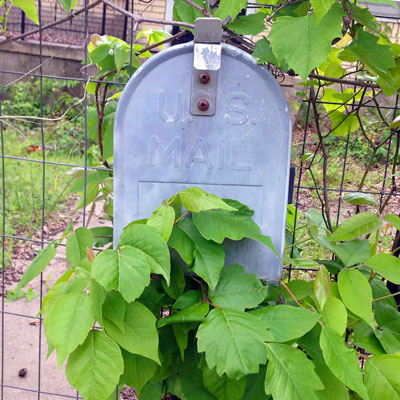Poison Ivy Protection
I get a ton of questions about controlling poison ivy every year. I’ve brought the facts and control measures for it.
Poison ivy is a perennial vine, meaning that it establishes itself as a woody vine and comes back larger and stronger each year.
Some people will refer to it as “poison oak” or “poison sumac,” but we don’t have those in Texas. The plant that we have here in Texas is Toxicodendron radicans. You can always identify it by its 3-leaflet leaves.

Facts about poison ivy:
• Be sure you can identify poison ivy, even as small seedlings, before you go out into the garden to work. Teach your young children as well.
• All parts of the plant have the oils that can cause the allergic reaction – roots, stems, leaves and berries.
• We are all susceptible at some point in our lives. Some people are always at risk. Others are most vulnerable when they’re coming down with a cold or other illness. We must assume that we are allergic.
• Wear disposable gloves, long pants, closed shoes, socks, long-sleeved shirts, hat and face protection while you’re working around poison ivy. Do not touch your skin with your gloves, and do not touch cutting surfaces with your hands.
• Use a pitchfork or rake to pick up cut debris. Do not use your hands. Pile it to burn or dry for a long period of time.
• Fumes from burning poison ivy can cause allergic reaction.
• Oils from the plants can be on the clothes you load into the washer.
• Take a long, soapy shower immediately after you work around poison ivy.
• If you develop a rash, talk to your pharmacist about the best medicines. If you have a serious reaction, talk to your doctor.
To eliminate poison ivy:
• Where you have a clear shot at it spray the vines with a broadleafed weedkiller containing 2, 4-D. Read and follow label directions carefully. You must not spray this herbicide, available in many brands, up into other trees and shrubs as it will kill them as well.
• Where the poison ivy is ascending into trees, take a long-handled axe or saw and cut through the ivy’s trunk near the ground line. Next, come up 18 inches higher and cut completely through its trunk a second time. Use the head of your axe to pop that 18-inch “log” out of the way. The top of the vine will die and remain in the tree. Do not try to pull it out. It will dry and gradually fall out of the tree at which point you can pick it up. In the meantime, use the axe to macerate the stump of the ivy, then pour the broadleafed weedkiller onto the stump at full strength and let it soak into the wood. That will prevent resprouting.

Don’t confuse Virginia creeper with poison ivy:
If you have a similar-looking vine, only with five-parted leaves, that’s the relatively harmless Virginia creeper. It, too, will shroud desirable plants with its growth, so you still want to eliminate it, but you don’t need to fear pulling on it. Just be sure the two vines aren’t growing together like they are in my photo.
